Meet some of the 2022 recipients of Canada’s most prestigious graduate awards, exemplifying academic excellence across the full range of disciplines.
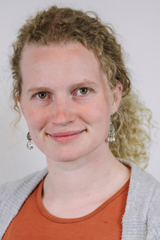 Raphaela Allgayer, Mining and Materials Engineering
Raphaela Allgayer, Mining and Materials Engineering
Understanding and modeling differences in heart valve calcifications between women and men.
Heart valve calcification leads to stiffening of the heart valves and eventually valve malfunction and death. The only treatment for the disease is surgical heart valve replacement. Men are more affected by heart valve calcification than women, but women are more likely to die of the disease. It was only discovered recently that the calcifications that form over the course of the disease are completely different in men and women. At the same severity of the disease, women have less calcifications, less crystalline calcifications, and different shapes and types of calcifications. The reasons for these differences are entirely unknown. In my Ph.D. project, we want to uncover the reasons behind these sex-differences by investigating human samples and a laboratory model for heart valve calcification. Understanding sex-differences in heart valve calcification better will allow us to develop sex-specific detection and treatment methods for the disease and improve the outcomes of women.
 Atia Amin, Human Genetics
Atia Amin, Human Genetics
Identification of novel biomarkers for the development of proactive surveillance tools for emerging tick-borne diseases.
Tick-borne diseases are an almost invisible fast-growing threat in North America. The tick, a tiny insect, can transmit more than 100 different bacteria to humans and animals with a single bite. Although severe consequences are preventable if the diseases are diagnosed at an early stage, the current diagnostic methods fail to do so. To find a solution, I am developing a new diagnostic method, that will directly detect the presence of bacteria transferred by tick bites. I will exploit a type of small vesicles released by the bacteria that are readily available in the patient’s bloodstream following the tick bite. Interestingly, these vesicles carry some molecules that are unique to each bacterium. By identifying and targeting these unique molecules, I aim to deliver a novel diagnostic test, which will help detect multiple bacteria with a single test early following infection and prevent the progression to severe conditions in patients.
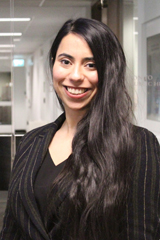 Jasleen Arneja, Epidemiology, Biostatistics and Occupational Health
Jasleen Arneja, Epidemiology, Biostatistics and Occupational Health
Estimating the causal effect of paid sick leave on health status and healthcare utilization: Implications for the design of equity-focused policy interventions
Socioeconomic factors are often the driving force behind health inequalities. By addressing these root causes, known as the social determinants of health, social policies have the potential to improve population health and reduce health disparities. Changes to national level social policies can act as natural experiments and provide a unique opportunity to examine the impact of the policies and various aspects of the policies on healthcare utilization and health status. Using quasi-experimental methods often used in epidemiology and economics, I will leverage changes to national level social policies to study causal impacts on population-level health. In a world with limited resources, the efficient utilization of healthcare resources is a priority; thus, upstream actions that address the “causes of causes” of preventable negative health outcomes is of great importance.
 Sashika Bandara, Family Medicine
Sashika Bandara, Family Medicine
Understanding the political economy of tobacco control and production to facilitate comprehensive tobacco control policies in Zimbabwe.
Shashika’s doctoral research focuses on global health policy and governance. His doctoral thesis will examine improving implementation of Framework Convention of Tobacco Control (FCTC) in low- and middle-income countries. Shashika will particularly look at how context influences the FCTC implementation efforts. Zimbabwe, the highest tobacco producer in the African region, will be a focused case study in his research to examine the political economy of tobacco and advance supply reduction pathways especially related to Article 17 of the FCTC. Shashika will be working in collaboration with Marondera University of Agricultural Sciences and Technology, Marondera and Training and Research Support Center, Harare in Zimbabwe. Shashika will be working with Dr. Raphael Lencucha as his primary advisor.
 Alice Curtin, Physics
Alice Curtin, Physics
Calibrating the CHIME/Outriggers Instrument for Fast Radio Burst Localizations.
Fast radio bursts (FRBs) are extraordinarily energetic bursts of radio emission lasting for a fraction of a second. Emanating from galaxies millions of light years away, FRBs can be used to look back in time at astronomical events occurring over vast periods of time and space. However, for most of the FRBs identified so far, we cannot yet pinpoint their precise locations and hence their host galaxies. Adding on to this, we still do not know what creates these enigmatic events. My research focuses on the powerful Canadian radio telescope, CHIME/FRB, and a new project (the CHIME/Outriggers) that is building miniature CHIME/FRB telescopes to determine exactly where FRBs come from. This work will provide a crucial building block for the study of FRBs both as astronomical events of great significance in their own right, and as a window for unlocking the mysteries of our Universe as a whole.
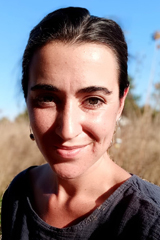 Olivia del Giorgio, Geography
Olivia del Giorgio, Geography
Beyond deforestation: Characterizing land control dynamics along agricultural commodity frontiers.
I am a human geographer and land use scientist, with a background in ecology. My work examines the dynamics of land control, dispossession and displacement, and land-use change in regions experiencing the expansion of large-scale, commodity agriculture. Motivated by my interests in environmental and social justice, humanitarian mapping, and agrarian reform, the focus of my PhD research is to investigate the drivers and social-ecological repercussions of land control changes in agricultural frontiers of the South-American Gran Chaco. To do so, I am combining remote sensing and GIS with political ecology and ethnographic methods.
Personal page: www.oliviadelgiorgio.com
Group page: lendev.weebly.com
 Africa Ixmucane Flores-Anderson, Natural Resource Sciences
Africa Ixmucane Flores-Anderson, Natural Resource Sciences
Enhancing Land Cover Change Analysis in the Tropics
My research focuses on advancing the detection of forest change in tropical areas using multiple satellite resources, including Synthetic Aperture Radar (SAR) and optical satellite data. The main objective is to strengthen forest monitoring systems by improving the timing and accuracy of forest change detection. My research will expand our understanding on the types of deforestation that SAR and optical datasets can detect, and how these two different types of satellite sensors can complement each other to improve forest change detection.
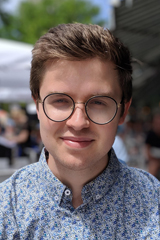 Adam Groh, Integrated Program in Neuroscience
Adam Groh, Integrated Program in Neuroscience
Unveiling the Unique Transcriptomic Landscape of Ependymal Cells in Multiple Sclerosis and Neurodegeneration: A Multimodal Study of Cerebrospinal Fluid Dynamics and Periventricular Inflammation
Adam Groh is a third year PhD candidate working in the laboratory of Dr. Jo Anne Stratton at the Montreal Neurological Institute-Hospital. His research focuses on ependymal cells, a ciliated epithelium that lines the cerebral ventricles and regulates cerebrospinal fluid flow and exchange throughout the brain. Despite emerging evidence to suggest that the ependyma is disrupted both in aging and neurodegenerative disease, the downstream functional implications of a dysregulated ependymal monolayer remain unclear. Adam’s research will investigate the influence of ependymal ciliary disruption on wider brain health using a novel transgenic animal model and interrogate how the human ependymal transcriptome may be altered during neuroinflammation via single cell and nucleus RNA sequencing of human brain tissues. With the advent of unique insights into ependymal biology, these cells represent a prime target for future pharmacological intervention given their unique neuroanatomical locale bordering the cerebrospinal fluid.
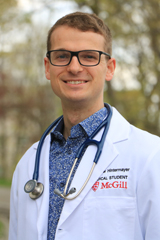 Matthew Hintermayer, Neurology and Neurosurgery
Matthew Hintermayer, Neurology and Neurosurgery
Identifying and modulating pro-regenerative micro-RNA signalling networks to promote neuronal recovery following axonal injury.
When neurons in the central nervous system (CNS) are injured, they fail to regenerate, leaving individuals who sustain neurotrauma with lifelong deficits. However, some types of neurons outside of the CNS do regenerate after injury. So, what are the important differences between the neurons that regenerate after injury and those that do not? To answer this question, my research investigates a class of small non-coding RNA molecules called micro RNAs (miRNAs). Individual miRNAs regulate the expression of hundreds of genes, modulating complex functions such as neurite outgrowth and cell survival. I developed a computing approach to predict miRNAs that control regenerative programs in neurons and am conducting experiments to directly measure which miRNAs get turned ‘on’ and ‘off’ when neurons are regenerating. By identifying these miRNAs and elucidating their mechanisms of action, we will better our understanding of the fundamental biology governing regeneration and identify potential RNA therapeutics for neurotrauma.
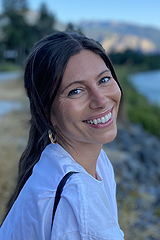 Kelsey Huson, Educational and Counselling Psychology
Kelsey Huson, Educational and Counselling Psychology
Traditional healing and culture-related substance use disorder treatment transformations due to the COVID-19 pandemic: Impact on Indigenous patients and communities
Kelsey’s proposed research will evaluate the COVID-19 pandemic’s impact on accessible traditional healing and culture-related treatment for substance use disorders (SUD), including successes and challenges related to service disruptions and innovations. Qualitative interviews and talking circles with key stakeholders, clinicians, patients, and community members will be conducted in partnership with six Indigenous organizations. Questions will explore SUD patients’ responses to the pandemic, as well as successes, challenges, and recommendations to improve access to, and quality of, traditional healing and culture-related interventions to promote recovery. Promising practices will be reported to enhance traditional healing and culture-related SUD treatment beyond the pandemic. The study will be guided by a Two-Eyed Seeing framework and will be conducted in consultation with an Indigenous research advisory council. Data will be analyzed using thematic content analysis. Study findings will be disseminated to Indigenous communities and organizations across Canada, as well as to federal and provincial agencies.
 Dana Jafarpour, Oral Health Sciences
Dana Jafarpour, Oral Health Sciences
3D Printed Dental Prostheses for the Elderly as a Public Health Strategy: A Randomized Controlled Trial
Edentulism (complete tooth loss) is prevalent in the elderly, affecting 21.7% of ≥60 year-old Canadians. While edentulism degrades the quality of life and general health, treatment with dentures can recuperate appearance, chewing, and speaking. Still, traditional methods for denture fabrication require several complex appointments, thus resulting in high costs for patients treated in private settings. The computer-aided design and manufacturing (CAD/CAM) technology can act as a game-changer for better access to care by these patients. Providing CAD/CAM dentures can drastically enhance oral healthcare access by edentulous elderly given the expected benefits including its simpler, faster, and more affordable mode of fabrication than those obtained traditionally. Yet, dental care providers need comparative studies before adopting digital methods. We aim to carry out a randomized clinical trial to compare the traditional vs CAD/CAM 3D printed mandibular overdentures. Results can change clinical practice and public health policies on restoring a functional dentition for seniors.
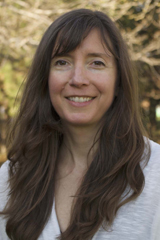 Stephanie Leite, Integrated Studies in Education
Stephanie Leite, Integrated Studies in Education
Integrate and Transform: Secondary Education in Times of Climate Change
Climate change is adding stress to our global ecosystem, economy, and wellbeing. Taking meaningful action to address the worst impacts of climate change means developing systemic approaches to understanding and educating about it. However, the way we teach in secondary schools does not cultivate the multifaceted, systems thinking needed to address complex issues such as climate change. Research supports the need to reorient both curriculum and pedagogy to support the development of sustainable ways of living; however, assessment is rarely included in research and policy on climate change education. My doctoral research examines how curriculum, assessment, and pedagogy can be integrated and used as access points to reorient schools towards transformative climate change education. Research will be carried out with secondary school teachers to co-construct an open-source collection of resources and processes that will inform a transformative climate change education framework.
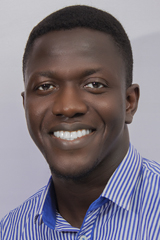 Oluwagbemiga Oyinlola, Social Work
Oluwagbemiga Oyinlola, Social Work
Meaning-Making from Caregiver’s Experiences Supporting older persons with Dementia in Nigeria.
I have strong practice and research experience in the field of medical social services in Nigeria, with demonstrated leadership positions both locally and internationally. I am interested in the Afrocentric dementia caregiving practice, advance directives, and end-of-life planning among older adults. My doctoral research will collaborate with geriatric centres in the Southwestern region of Nigeria to recruit family caregivers for persons with dementia. In keeping with the principles of phenomenology, the interviews will be open to encourage caregivers to provide detailed and narrative descriptions of their experiences supporting persons with dementia, their beliefs about the condition, and the meanings they ascribe to their circumstances. As a social work leader and emerging African scholar, I have noted the growing discrepancies between the challenges faced by dementia caregivers from the Yoruba community and the knowledge base and service systems available to support these caregivers. Therefore, I see this research as a first step towards closing this gap by informing the development of policies and practices more closely aligned with the realities, insights and needs of this growing population of caregivers.
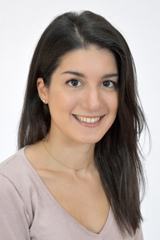 Elissavet Pertigkiozoglou, Architecture
Elissavet Pertigkiozoglou, Architecture
Programmed Collaboration: Work Relationships in Software for Building Design, 1970-2010.
To what extent can collaboration be “programmed”? Today, digital collaborative platforms promise seamless communication through data sharing among team members. In architecture and engineering practices, a set of such technologies known as Building Information Modelling (BIM) has become pervasive, transforming how practitioners from various disciplines collaborate on the design and construction of buildings. To develop an understanding of this transformation and, by extension, the effects of collaborative platforms in today’s emerging digital economy, my research takes on a critical and historical approach. I look at how software for building design collaboration emerged and the visions and institutions that shaped its current form. My research explores how such software aimed to standardize interdisciplinary exchanges, embedding historically specific understandings of group work and professional roles into technical infrastructures whose legacy survives in today’s technologies.
 Sherilyn Junelle Recinto, Integrated Program in Neuroscience
Sherilyn Junelle Recinto, Integrated Program in Neuroscience
Dysregulated Immune Response in the Gut Underlying Early Parkinson's Disease Symptoms.
Parkinson’s disease (PD) is characterized by the progressive loss of midbrain dopaminergic neurons, leading to motor deficits. Decades prior, PD patients often already manifest various autonomic dysfunctions, including constipation. Intestinal inflammation and infection also positively correlate with incidence of PD. However, little is known about the mechanisms at play during the evolution of disease partly due to the lack of animal models able to recapitulate the protracted nature of neurodegeneration originating in the gut. Our aim is to further characterize a model that we had previously established, exhibiting late PD-like phenotypes after repeated gut infection of mice deficient in a PD-related gene (PTEN-induced kinase 1, Pink1). To this end, we will perform spatial-temporal analyses across the gut-immune-brain axis to decipher molecular changes in immune response at the single-cell resolution following acute bacterial infection and uncover how this leads to cytotoxic neuroimmune interactions in the gut potentially underlying prodromal PD symptoms.
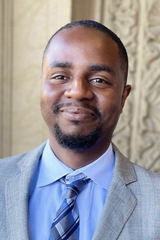 Yuri Alexander Romaña-Rivas, Civil Law
Yuri Alexander Romaña-Rivas, Civil Law
In Pursuit of the Mountaintop: When Transitional Justic is Not Enough. The Case for a Racially Transformative Justice System for Racialized Communities.
Racialized communities (RC) that have been subjected to systems of oppression such as enslavement, colonialism, and structural racism tend to be disproportionately impacted by armed conflicts (AC). However, Transitional Justice (TJ) processes established to overcome the causes and effects of AC do not sufficiently focus on addressing the underlying causes of oppression that have made RC more susceptible to disproportionate impacts from AC. Therefore, I argue that attempting to take these RC back to the status quo ante of AC may not be enough to overcome the situation of structural violence that has led them to suffer far more from AC. By using Colombia as a case study, international law, Critical Race Theory, and analyzing other countries' experiences with TJ processes, I further argue for TJ to incorporate, within its framework, transformative measures with a racially-sensitive approach to address the underlying historical and structural causes of violence impacting RC.
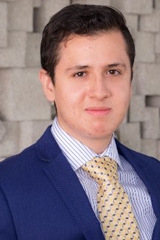 Joan Miguel Romero, Experimental Medicine
Joan Miguel Romero, Experimental Medicine
Elucidating Molecular Subtypes of Pancreatic Cancer for Immunotherapy
Pancreatic cancer is the 3rd leading cause of cancer deaths, with less than 10% of patients surviving this cancer longer than 5 years. An important reason for this lethality is pancreatic cancer does not respond well to chemotherapies and immunotherapies. For treatments like immune checkpoint inhibitors (ICIs) to work, cancers need many immune cells called CD8+ T cells within the tumour, a phenomenon called T cell-inflammation. We hypothesize pancreatic cancers with T cell-inflammation have specific genetic mutations and phenotypes making them more likely to respond to ICIs. My PhD focuses on identifying these subtypes that may respond to immunotherapies, particularly a specific group called homologous recombination repair deficient tumours. To investigate this, I will use bioinformatic approaches using next-generation sequencing data from patients, and preclinical trials using mouse models developed in the laboratory. Understanding how T cell-inflammation occurs in pancreatic cancer will help physicians identify which patients should be treated with immunotherapies to improve outcomes.
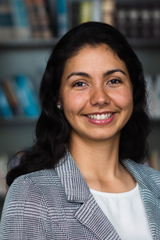 Yessica Salas-Navarro, Earth and Planetary Sciences
Yessica Salas-Navarro, Earth and Planetary Sciences
Predicting the Unpredictable: A New Scientific Approach to Forecast Volcanic Eruptions.
My project proposes a new scientific approach to potentially forecast volcanic eruptions. I have designed a new instrument that allows scientists to measure carbon dioxide (CO2), which is a major gas in magma, and my instrument will allow scientists to also measure methane (CH4). This is important because when magma rises to the surface before an eruption, the CO2 concentration relative to the CH4 concentration at the surface will increase. By effectively reading when these gases increase, my approach could predict an eruption. These changes can happen rapidly, therefore continuously monitoring volcanic gases is key to detecting sudden changes. My revolutionary instrument would allow us to measure these gases together on a continuous basis for the first time. This will vastly improve our understanding of the interactions underneath a volcano that trigger volcanic eruptions. In summary my project seeks to better inform decision-making about risk prevention and hazard assessment worldwide.
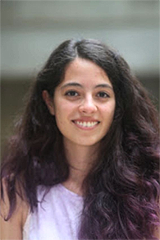 Sofia Skromme Carrasco, Integrated Program in Neuroscience
Sofia Skromme Carrasco, Integrated Program in Neuroscience
For most of us, knowing how to get from our home to our workplace or school is second nature. We know where to turn right or left, and even when returning to our hometown years after our last visit, we can use the same landmarks to orient ourselves on our path. In Alzheimer’s Disease, spatial disorientation is one of the first symptoms to appear, and most patients will experience this at some point. Deficits in spatial memory become apparent before any other memory deficits, indicating that these impairments could be used as an early indicator of the disease. The aim of this project is to study how the Retrosplenial Cortex, a region in the brain that acts as an interface between vision and spatial navigation, creates a map of our environment to help us orient ourselves.
 Mark Sorin, Human Genetics
Mark Sorin, Human Genetics
Improving response to immunotherapy for lung cancer patients.
Lung cancer is the leading cause of cancer mortality worldwide with more people dying from lung cancer than colorectal, pancreatic and breast cancer combined. Non-small cell lung cancer, a subtype of lung cancer, accounts for most cases and exhibits poor response to conventional cancer therapies. New treatments called immunotherapies activate the immune system and have led to impressive results in a subset of patients as they enable the body to improve its ability to fight cancer. Unfortunately, this treatment only works for a very small proportion of patients, with most patients not responding at all. Therefore, it is critical to identify new treatments that can improve the effects of immunotherapy so more lung cancer patients can benefit from its effects. We investigate how to improve the anti-tumor immune response in lung cancer patients receiving immunotherapy. Using preclinical models, we test novel treatment combinations that may synergize with existing immunotherapy regimens.
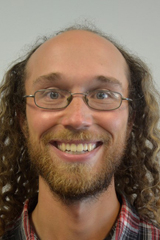 Scott Sugden, Natural Resource Sciences
Scott Sugden, Natural Resource Sciences
Biogeochemical activities in pioneer soils at biologically relevant scales.
As glaciers recede because of ongoing climate change, they expose large new areas of nutrient-poor soil. These newly exposed soils are quickly colonized by microorganisms, which play an important role in determining whether these soils become carbon sinks or sources in the years following deglaciation. The overall carbon flow into or out of deglaciated soils can, in turn, affect the global carbon budget, making an understanding of carbon flows in these systems essential to predictions of future climate change. In my research, I will use a combination of single-cell and bulk soil analyses to explore how soil microbial communities, their cell-to-cell interactions, and the physicochemistry of their habitat affect carbon source-sink dynamics in deglaciated environments in the Arctic and Antarctic. My research will contribute to a high-resolution understanding of the pathways and processes that drive carbon cycling in some of the most rapidly changing ecosystems on the planet.
 Minghan Xu, Mining and Materials Engineering
Minghan Xu, Mining and Materials Engineering
Multiphysics modeling of permafrost adaptation due to climate change in Northern Canada using renewable energy-based artificial ground freezing.
I have a strong interest in the physics of phase change phenomena. My research integrates mathematical modeling, statistical analysis, and experiments to advance our fundamental understanding of phase change, particularly the freezing and melting processes of pure substances, binary mixtures, and porous media. The fundamental research can benefit applications in phase change materials (PCMs), artificial ground freezing (AGF), spray freezing, and cold thermal energy storage. For my doctoral thesis, I aim to predict complex physical phenomena contributing to thawing permafrost due to climate change, and design a sustainable storage system (i.e., renewable energy based AGF with PCMs) to stabilize permafrost in Northern Canada. The system is capable of extracting and storing cold energy in winter which can then be supplied to keep permafrost frozen throughout the year. The outcomes of this research will therefore help vulnerable northern communities and critical infrastructure in their effort to adapt to a changing climate.
 This work is licensed under a
This work is licensed under a